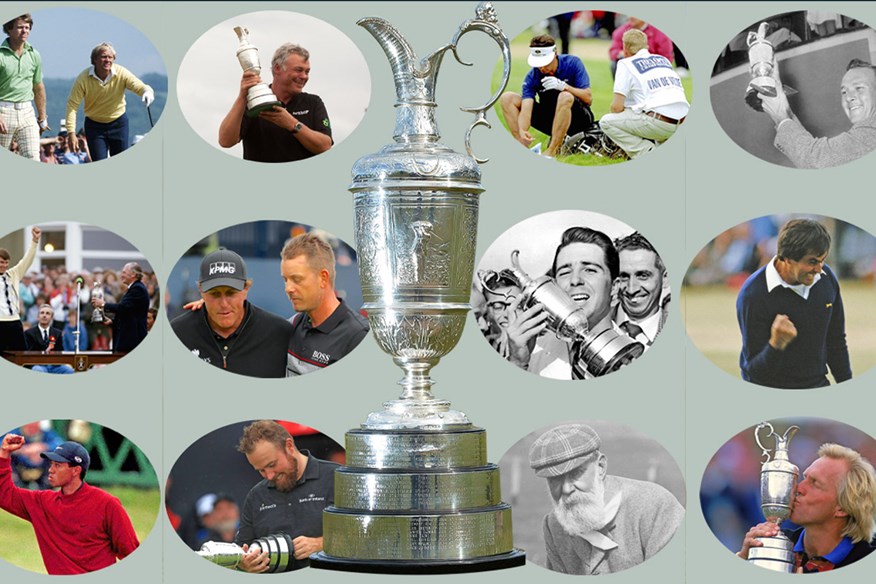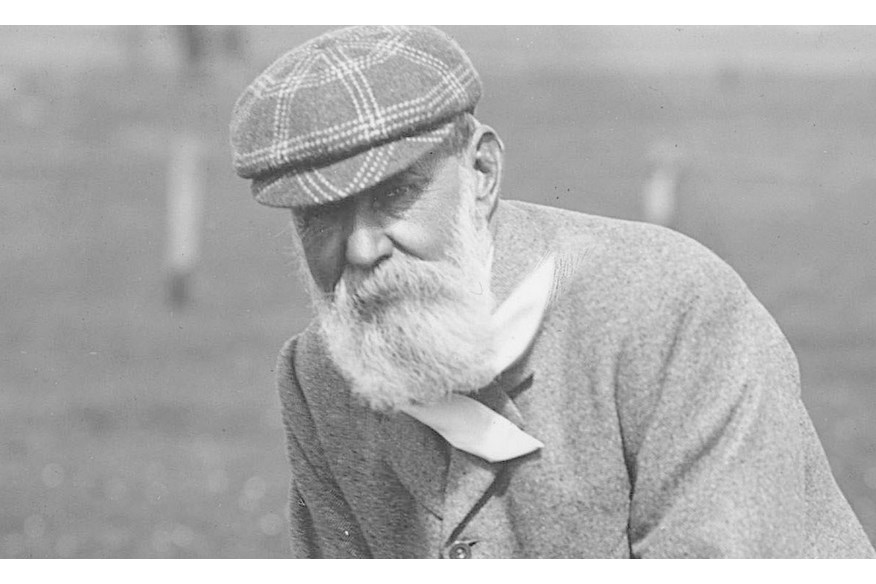The 40 most iconic moments in the history of the British Open Championship
Last updated:
We look back at the greatest moments from the history of golf’s oldest Major.
The Open has been the source of some of golf’s most iconic moments. For the lucky ones, it was all about the glory, but there has also been a great deal of pain along the way.
We delve into the archives to reveal the moments that have made the only men’s Major played on British soil loved around the globe.
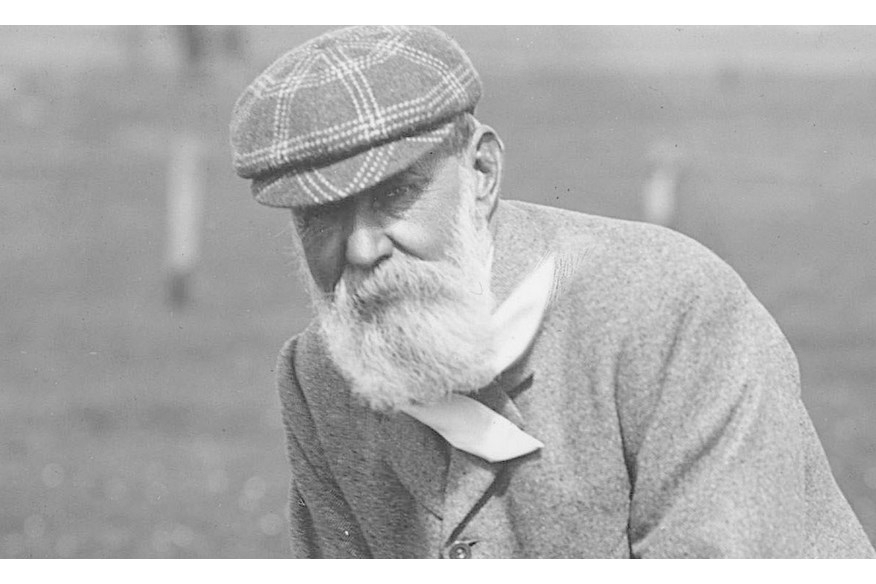
1) A family affair – Prestwick, 1860
The Open Championship was first played on October 17, 1860 at Prestwick Golf Club, the tournament devised to determine who would succeed the recently deceased Allan Robertson as the ‘Champion Golfer’. From a field of eight, that man turned out to be Willie Park Snr, a two-stroke winner from Tom Morris Snr. But it was Old Tom who quickly took a stranglehold on the tournament, winning four of the first eight installments, all played over Prestwick’s links.
The most notable moment of those formative years came, however, in 1868, when Old Tom (pictured above) was denied a fifth victory in dramatic fashion, beaten into second place by his own son, Young Tom. Aged 17 years and 156 days, this was the year Young Tom came of age, prevailing by three strokes to win the first of four consecutive Open Championships.
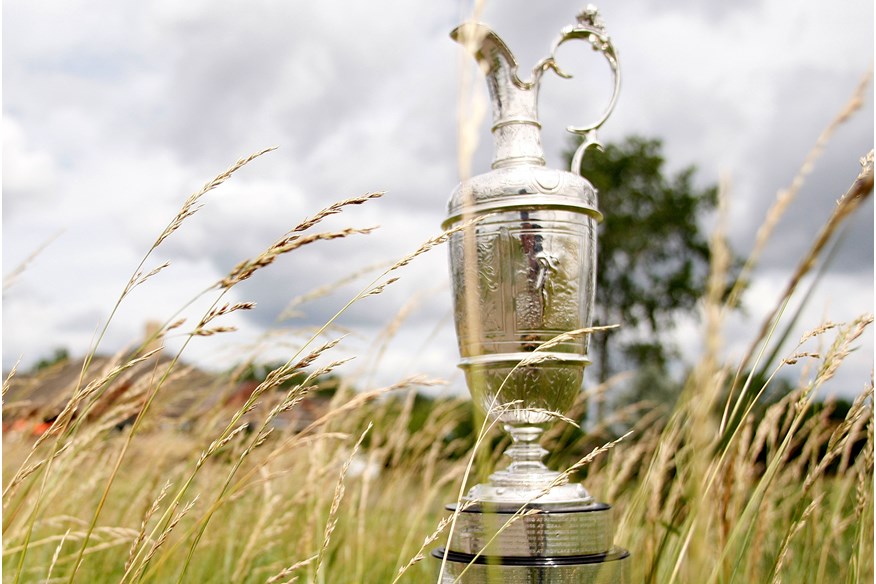
2) The Claret Jug is born – Scotland, 1873
Up until 1873, Open hopefuls were playing for the Challenge Belt, a length of Moroccan leather embellished with silver panels. When that belt was won for a third consecutive time and therefore outright by Young Tom Morris (right) in 1870, St Andrews, Musselburgh and Prestwick golf clubs finally agreed to host The Open, each donating £10 towards the cost of a new trophy. They ordered an ornately decorated silver claret jug made by Edinburgh silversmiths Mackay, Cunningham & Co.
The jug stands 20 inches tall and weighs approximately 5.4Ib. The R&A currently have several versions of the Jug, the original from 1873, a replica made in 1927 and three relatively modern versions. The Champion Golfer of the Year receives the 1927 version of the Jug to keep for a year, then gets a smaller version to keep forever.
Here’s everything you get for winning The Open.
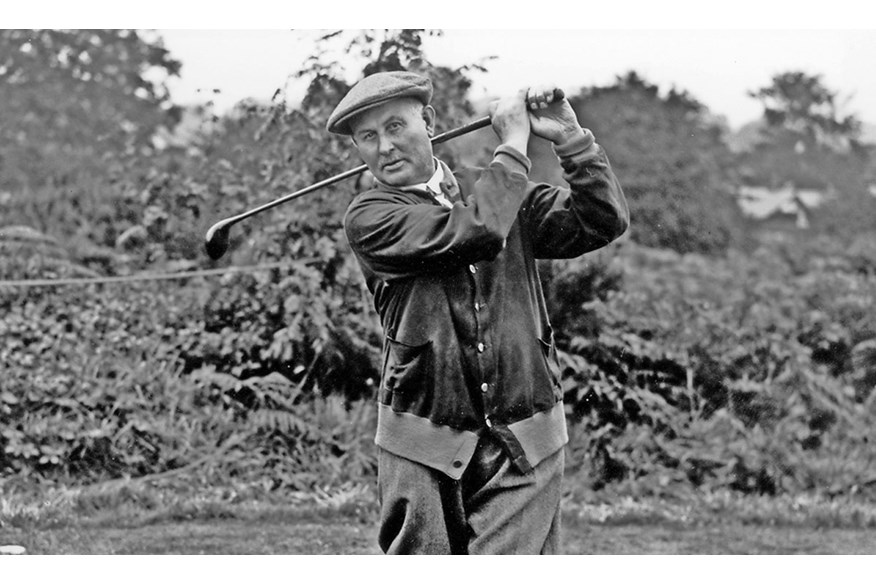
3) Vardon’s sixth victory – Prestwick, 1914
By 1914, golf’s Great Triumvirate had monopolised The Open Championship. James Braid, J.H. Taylor and Harry Vardon (pictured above) had amassed 15 titles between them, level on five victories each. The 64-year-old Taylor arrived at Prestwick to defend his title and found himself with a two-shot lead over Vardon going into the fourth and final round, a second-round 82 all but ending Braid’s hopes.
Distracted by the large crowd gathered around them, Taylor’s game deserted him, dropping strokes at eight, nine, 10 and 11 to hand Vardon a five-stroke lead and his sixth Claret Jug. Since Taylor’s first win in 1894, the Great Triumvirate had won 16 Opens in two decades – and no man has ever bettered Vardon’s six Open victories. The outbreak of World War I brought that remarkable sequence to an end.
4) The ‘Impregnable quadrilateral’ – Royal Liverpool, 1930
Bobby Jones became the only amateur to win the Claret Jug three times with victory at Hoylake in 1930. But what elevated his two-stroke victory above those previous two was the bigger picture: Jones had made a bet that he would complete the Grand Slam that same calendar year – winning our Amateur Open and Open, and the US equivalents. Victory at St Andrews in May sealed the Amateur, followed less than a month later by a two-stroke victory in The Open.
Twenty-two days later he won the US Open and completed the ‘impregnable quadrilateral’ by winning the US Amateur in late September. Following a ticker-tape celebration through the streets of New York, he promptly retired – the greatest amateur the game will ever see.
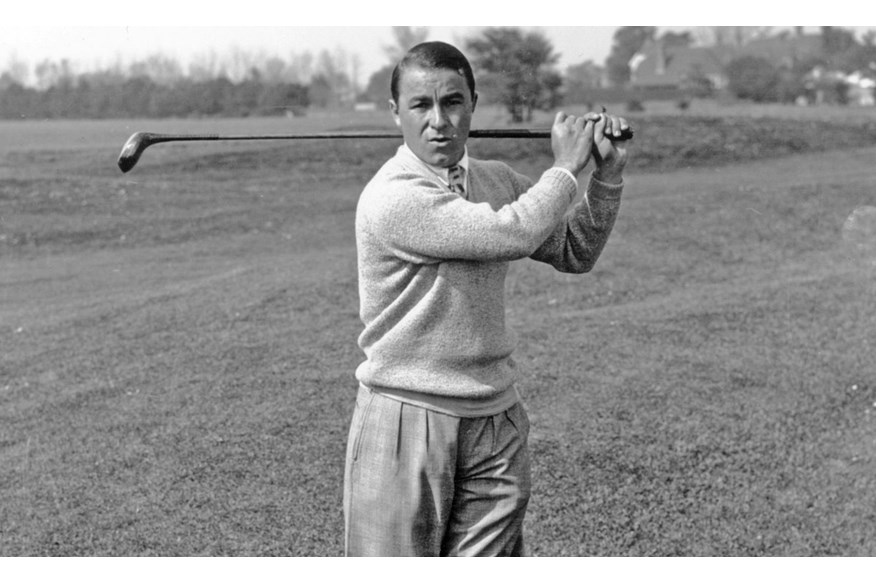
5) Armed and dangerous – Prince’s, 1932
Gene Sarazen’s victory in the 67th Open Championship was largely routine, a wire-to-wire victory sealed by five shots. The real drama came when Sarazen (pictured above) found his first bunker, then drew from his bag a club that would alter the game forever.
Designed by his own hand, and inspired by the way air travels over an aeroplane’s wing, the club was lofted and with a flange lower than the leading edge so it would bounce through the sand. “The Weapon!” cried his rivals, and the sand wedge was born.
6) Bradshaw’s bottle – Royal St George’s, 1949
Ireland’s finest golfer, Harry Bradshaw looked to be atoning for missing the cut in the previous two Opens when the tournament arrived at Royal St George’s in 1949. Well placed after the first round, in the second he found his ball had come to a stop on broken glass.
Oblivious to the free drop he was entitled to, he hit it as it lay and could only propel it 30 yards down the fairway, dropping a shot. Regrettable at the time, it proved to be ruinous when Bradshaw finished the week five-under with a score of 283 – tied for the championship with Bobby Locke. With a night to contemplate his error, he returned the following day and lost the play-off by 12 strokes.
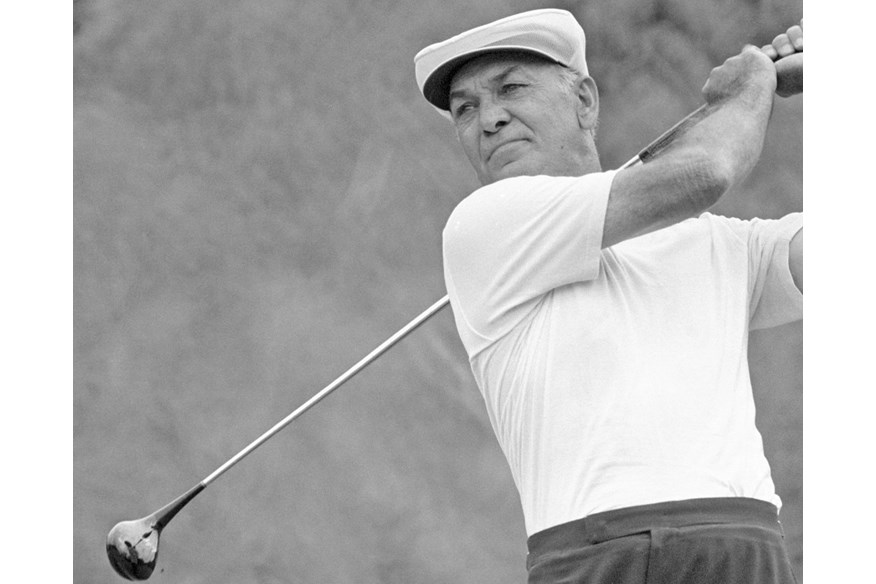
7) Hogan’s heroics – Carnoustie, 1953
In 1953, Ben Hogan (pictured above) had already won the Masters by five shots and the US Open by six when a date clash forced him to decide between playing The Open or the US PGA. Fearing his legs would not withstand 36-hole matches, he elected to play Carnoustie, in what turned out to be his only Open.
Rounds of 73, 71, 70 and 68 illustrated how the challenge grew on him, Hogan finding ways around Carnoustie others simply couldn’t – and creating Hogan’s Alley by threading his tee shot on the sixth hole between the fairway bunker and the OOB stake just a few yards apart. Cheered on by huge galleries – including Frank Sinatra – Hogan raced to a four-shot victory.
He vowed to come back and play The Open again, but never did.
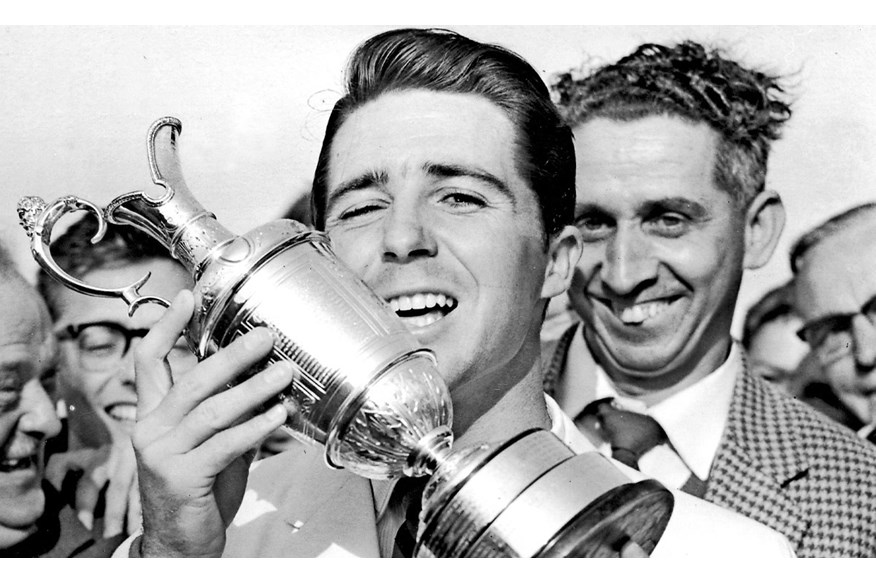
8) No kind of Player – Muirfield, 1959
Gary Player didn’t quite get the reception he expected from Muirfield’s infamous secretary Colonel Brian Evans-Lombe when he arrived 10 days ahead of the Open to practise. “Good morning, sir. I’ve come early to practise because I want to win The Open,” said Player (pictured above).
“You’re not practising here,” Evans-Lombe replied. Player finally got his own way, but opening rounds of 75 and 71 left him eight shots behind Fred Bullock going into the final 36-hole day. However, a 70 followed by a 68 gave Player the clubhouse lead. He went back to his hotel for a shower and returned in a white suit to watch the final group finish before being crowned the champion.
9) Kel kills The King – St Andrews, 1960
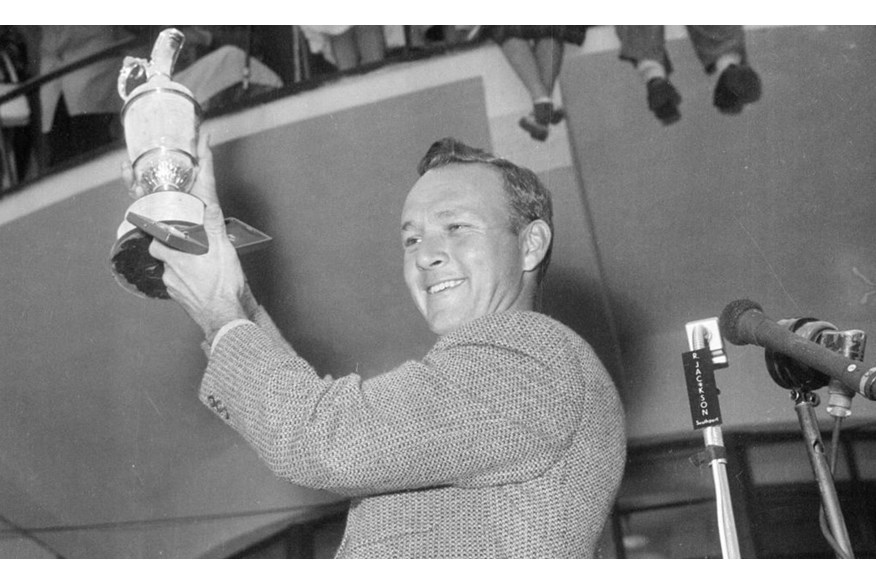
10) Arnie’s first Open win – Royal Birkdale, 1961
Arnold Palmer’s first Open victory came at only his second attempt (see 09) at Royal Birkdale. The King’s swashbuckling approach and famous 6-iron from the base of a bush defeated the wild weather and close attention of Dai Rees.
Credited with reinvigorating The Open in the eyes of his fellow Americans, Arnie (pictured above) won again the following year for good measure.
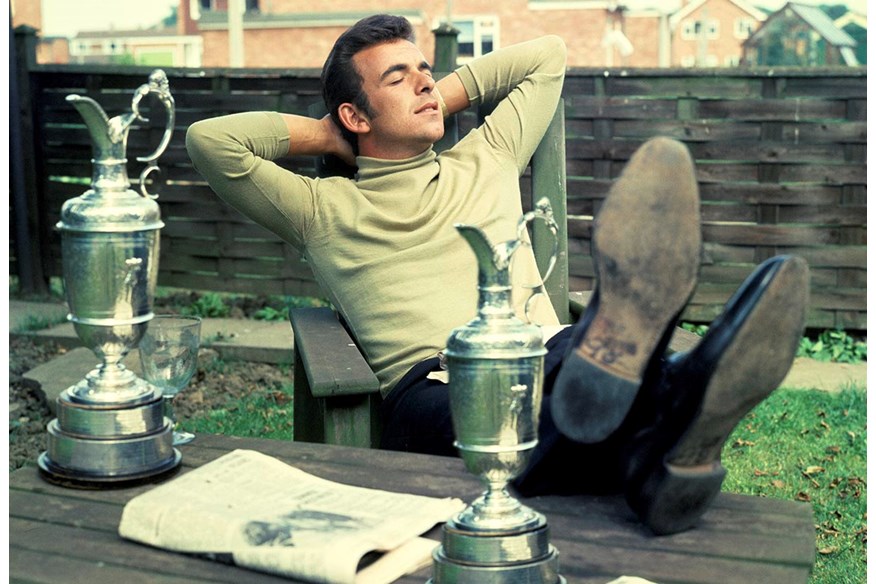
11) Jacklin’s joy – Royal Lytham, 1969
Eighteen long years had passed since a British golfer had tasted Open victory, a drought brought to a dramatic end by Tony Jacklin at Royal Lytham. Breathlessly pursued by Bob Charles, winner of the last Open at Lytham in 1963, the Englishman kept a clear head while the galleries around him were losing theirs.
Two shots ahead on the final tee, his drive found the fairway – “What a corker!” gasped commentator Henry Longhurst. A fine approach saw Jacklin mobbed by spectators invading the fairway and his shoe momentarily lost in the melee. Two putts sealed victory, Jacklin’s sole Open title.
12) The failed formality – St Andrews, 1970
A 30-inch putt was all that stood between Doug Sanders and his first Major victory – what The Observer’s Peter Dobereiner called “just longer than a formality.”
But there’s no such thing as a formality with Jack Nicklaus breathing down your neck. Sanders jabbed his putt wide, plunging him into a play-off in which Nicklaus prevailed. Sanders never came as close to winning a Major again.
Asked years later if he ever thought about the miss, Sanders’ replied, “Only every four or five minutes.”
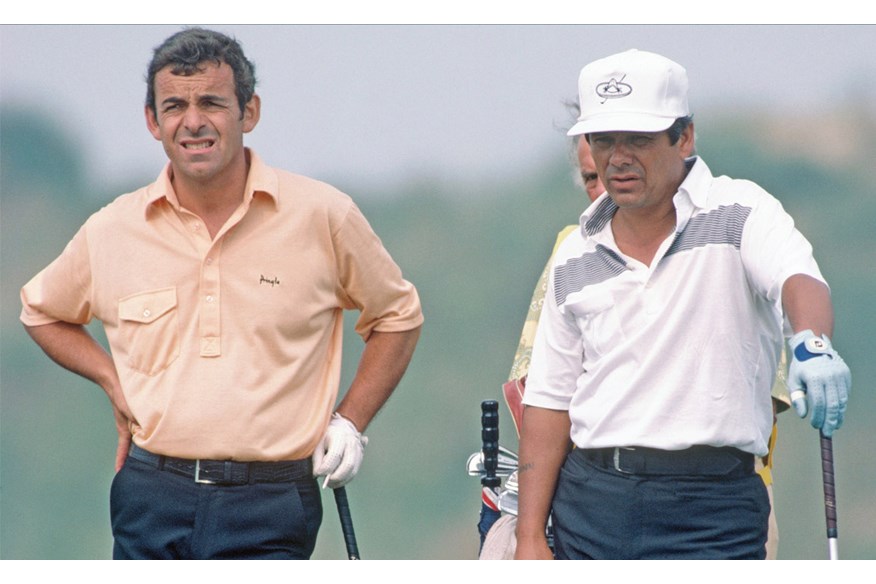
13) The Merry Mex defends his jug – Muirfield, 1972
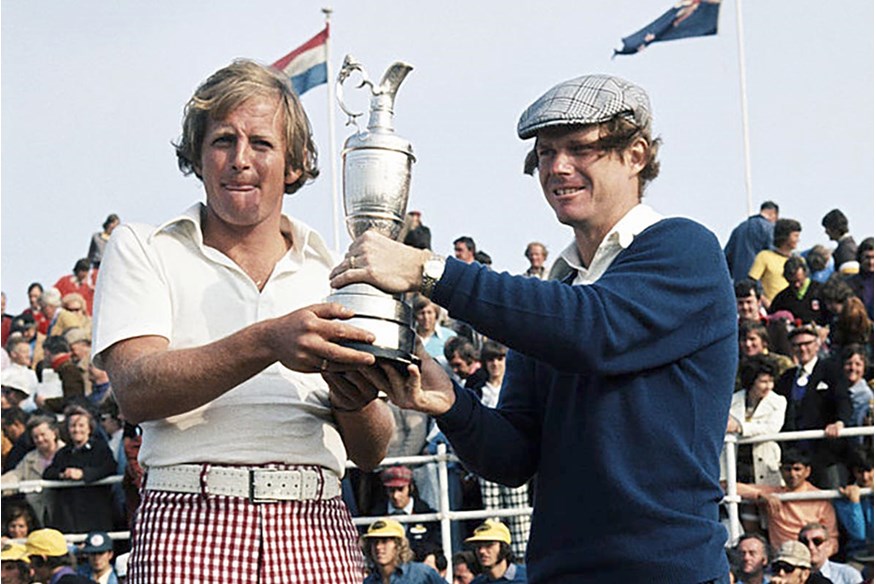
14) The pain and the glory – Carnoustie, 1975
Tom Watson’s introduction to The Open was inauspicious to say the least. The 26-year-old arrived at Carnoustie for the 1975 tournament only to be refused entry as qualifying was taking place. He decamped to Monifieth GC for his first taste of links golf and watched as his imperious first drive split the fairway, only to find his ball suddenly missing.
Ten minutes later he finally located it and declared his distaste for the genre: “I didn’t believe that was the way golf should be played.” When he finally got on Carnoustie a few days later, Watson changed his tune, beating Jack Newton in an 18-hole playoff to win on his debut – the start of a love affair that saw him win five Claret Jugs.

15) The Duel in the Sun – Turnberry, 1977
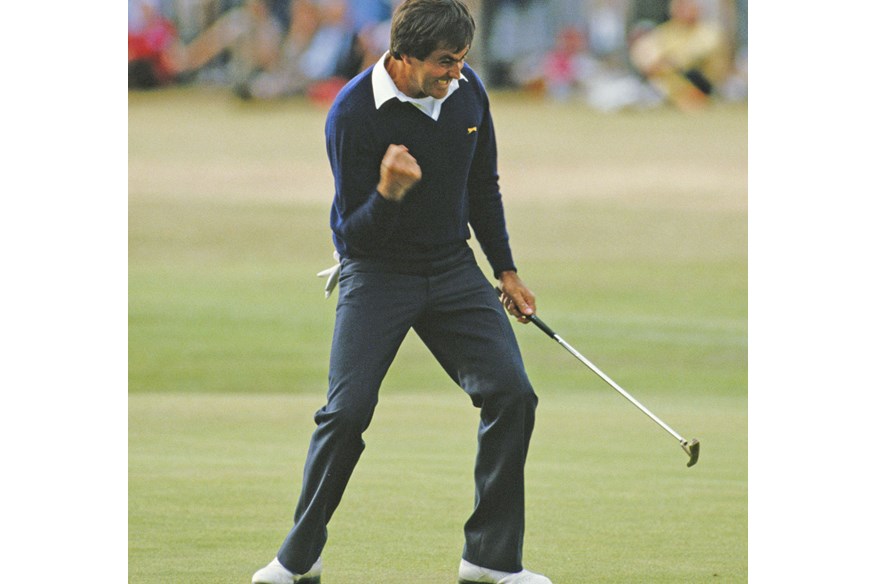
16) Seve – 1979, 1984 & 1988
The Open was the tournament that first introduced the magic of Seve to the world, the little-known 19-year-old taking the overnight lead heading into the final round of the 1976 Championship at Royal Birkdale, before finishing tied-second alongside Jack Nicklaus.
Three years later he went one better (18), becoming the youngest Open Champion in the 20th Century and the first golfer from continental Europe to win a Major since France’s Arnaud Massy won The Open in 1907.
Seve, as ever, was wild off the tee but fashioned miraculous recoveries. He hit nine fairways across the week at Royal Lytham & St Annes, and only one in the final round.
After a particularly wayward drive on the 16th, he knocked a wedge onto the green from the car park and made birdie. The ‘Car Park Champion’ was crowned, the only player to break par that day, securing a three-shot victory over Nicklaus and Ben Crenshaw.
The 1984 Open was meant to be all about Tom Watson as he bid to become the first man since 1956 to win the Claret Jug three years in a row, and match Harry Vardon’s six Open victories.
This swashbuckling Spaniard had his own ideas, though. Entering the final round two shots behind Watson, Seve went out in 34 to take the lead. By the time he reached St Andrews’ famous 17th, there was nothing to separate the pair.
Seve found thick rough on the left and looked certain to make bogey for the fourth day running. Somehow, he ripped a 6-iron almost 200 yards through the air and held the green, saving par. Watson, in the group behind, would bogey the 17th as Seve was rolling in a 15-foot birdie putt on the last to all but seal victory (19, pictured right). “It was the happiest single shot of my life,” he said.
His fifth and final Major came in 1988, at the site of his first – Royal Lytham & St Annes – by which time he was four years without a Major. Rain delays saw the first ever Monday finish as Seve and overnight leader Nick Price produced one of the greatest final rounds in Open history.
Trailing by one, Price hit the final green in regulation, meaning Seve likely needed to get up and down for the win. A trademark escape from greenside rough left a tap-in for victory (20). “I played about as well as this game can be played,” said the Spaniard of his 65.
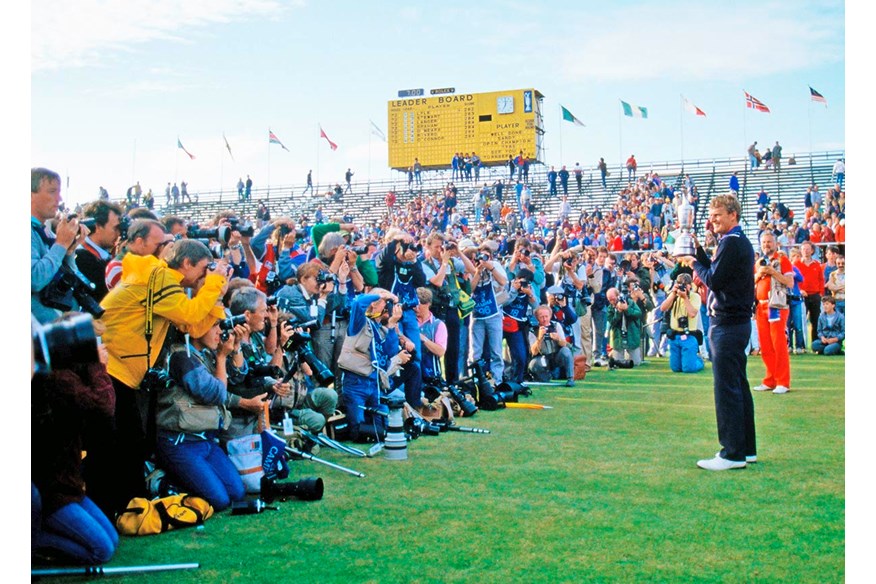
17) The floodgates open – Royal St George’s, 1985
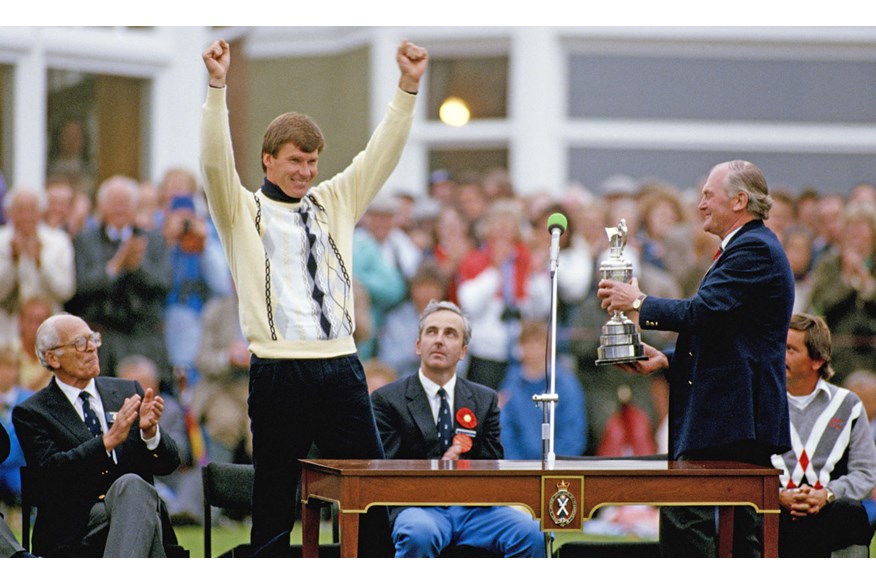
18) 18 pars – Muirfield, 1987
Another three-time Claret Jug winner, Nick Faldo’s first Open victory came at the 12th time of asking, secured at a mist-shrouded Muirfield in 1987 (21, below) and offering proof that his recently rebuilt swing could stand up to the most exacting examinations.
In the style of the hare and the tortoise, Faldo’s 18 pars reeled in long-time leader Paul Azinger to see him land a breakthrough Major. It was also a good time for clothing company Pringle. It’s oddly-designed jumpers flew off the shelves post Faldo’s first Open success.
19) Course record but no cigar for Norman – Troon, 1989
Greg Norman started the final day at Royal Troon seven back of long-time leader Wayne Grady but lit up the Ayrshire links by birdieing the first six holes on a remarkable final day. American Mark Calcavecchia also came charging through, helped by a remarkable slam-dunk chip-in at the 12th.
The Great White Shark would post a course-record 64 and that got him into a play-off with the unknown American and Grady, who could not match the other two in the history-making, four-hole shoot-out.
Norman and Calcavecchia were level playing 18, where the Open champion of three years earlier drove into a bunker that was considered out of range. Before he hit his second, the American hit one of the great long iron shots out of the rough to six feet. In response, Norman could only splash out and could do little as Calcavecchia rolled in the birdie putt for his first and only Major win.
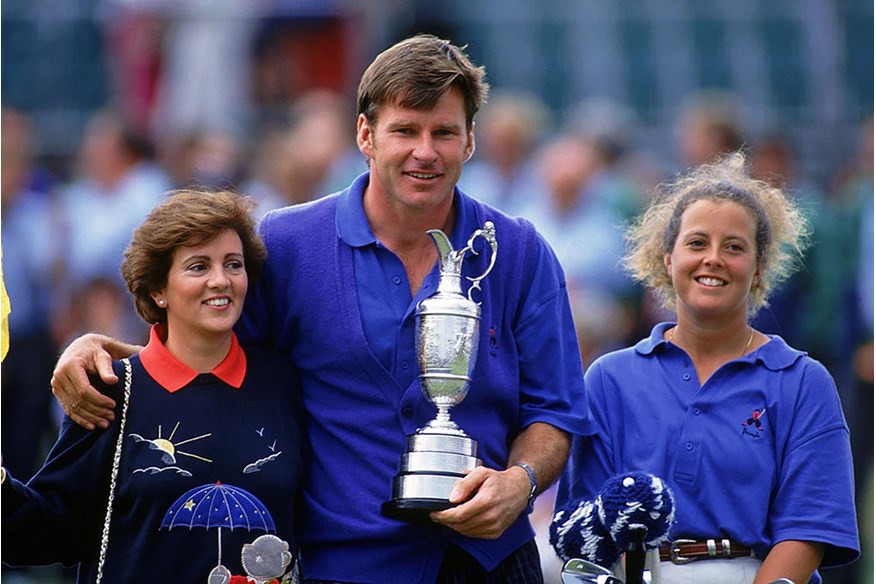
20) Peak Faldo – Muirfield, 1992
At Muirfield five years after Nick Faldo’s first Major success, he conjured up arguably the finest performance of his career and the final four holes of his life. A second-round 64 was close to perfection, with 130 strokes for the opening 36 a new Open record.
Yet as Faldo entered the final four holes of the 121st Open he found himself two strokes back of the American John Cook and needing something spectacular.
“I told myself that I had to forget about the whole week and play the best four holes of my life,” he later recalled. What came next was perhaps the shot of his life – the “half 5-iron” approach on 15 that scudded to within three feet for a birdie putt.
Par saved on 16, a birdie on the par-5 17th combined with Cook’s par saw the momentum swing. Having read the writing on the wall, Cook could only bogey the final hole as Faldo made par to confirm his fifth Major title in six years and his third Open Championship.
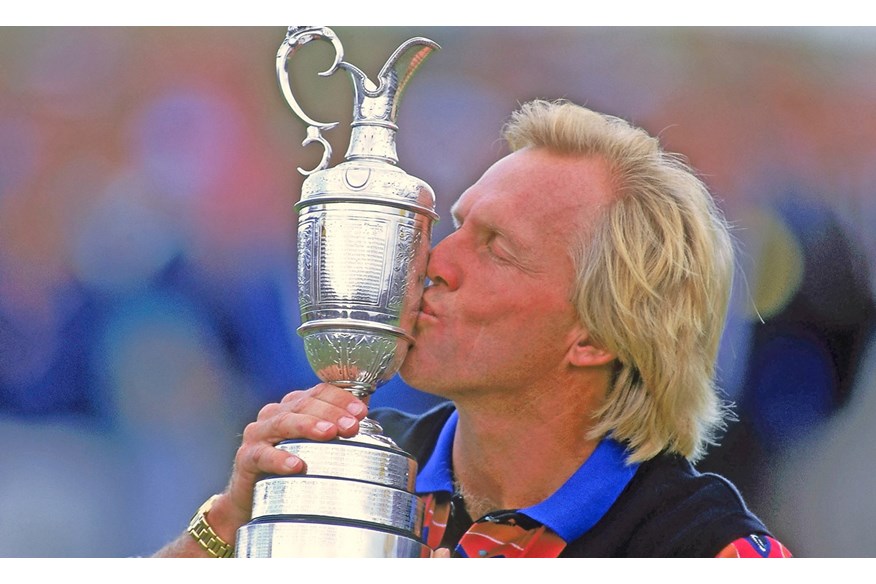
21) Norman conquest – Royal St George’s, 1993
Any doubters of Norman’s ability to get the job done were silenced in the summer of 1993. Trailing his old adversary Nick Faldo by two shots after 54 holes, the Australian’s final-round 64 saw him ascend to the top of a leaderboard of rare quality – all but one of the final top-12 was or would become a Major champion.
“This means more to me knowing I have beaten great players,” Norman said. “It was like playing a game of chess,” said one of those exceptional also-rans, Bernhard Langer. “He was invincible.”
Norman said: “I was driving the ball so great, I decided to take on a lot of the dog-legs. So, take it over the corner, hit it over the gallery, or hit it over a TV tower, or hit it over there becauseI’m hitting to the widest part of the fairway because I was hitting beyond the turning points. There were four or five holes where I really took advantage of that, and I didn’t back off.”
21) Price’s eagle – Turnberry, 1994
Twice a runner-up, in 1982 and 1988, Zimbabwean Price claimed his sole Open with a one-stroke victory over Jesper Parnevik at Turnberry. It came courtesy of a stunning late charge, first with a birdie at the 16th, then an improbable 50-foot eagle putt on the penultimate hole as the momentum swung all his way.
“I nearly jumped out of my skin when it went in,” he explained after Parnevik’s bogey finish had sealed his victory. “My heart was pounding.”
23) Rocca pounds the turf – St Andrews, 1995
The Sunday at St Andrews in 1995, and Costantino Rocca is dying in the Valley of Sin. John Daly was the clubhouse leader at six-under, a shot clear of the Italian. With Rocca almost driving the green at the last, a birdie looked inevitable – which would leave him level with the American.
But Rocca’s mind clearly wandered at that point, his chip chunked hopelessly into the Valley of Sin. His hopes dashed and his dreams seemingly dead, he then conjured up the impossible, a 50-foot putt that raced up the slope, across the green and into the hole. “Quite extraordinary,” noted Peter Alliss, as Rocca lay spread-eagled on the turf. It secured a play-off, but the mulleted Daly still prevailed.
24) Rose blooms – Royal Birkdale, 1998
Mark O’Meara walked away with the Claret Jug in ’98, but all hearts were won by a callow young man from Hampshire. Amateurs never win The Open any more, of course, but 17-year-old Justin Rose came as close as anyone could in firing a second-round 66 that equalled the amateur record and propelled him into the reckoning alongside Tiger Woods, Nick Price and Thomas Bjorn, tied second and just a shot off the lead.
Rose didn’t win, of course, a 75 dropped him back and left him three behind. Yet a gutsy Sunday 69 and unlikely pitch-in birdie at the last left him tied fourth and served notice of his rising reputation. England suddenly expected. Not too much, as it turned out, but too soon.

25) Tale of the unexpected – Carnoustie, 1999
Paul Lawrie’s victory at a brutal Carnoustie in 1999 was overshadowed by the sight of Jean van de Velde losing his mind in the burn on 18. But no-one had seen Lawrie’s victory coming. He hadn’t made an Open cut since 1995 and things appeared to be following form when he woke up on the Sunday morning 10 shots behind van de Velde – twice the previous record comeback margin. Eighteen holes later, Lawrie’s superb 67 left him six-over, but still seemingly short of the miracle he needed.
The likely French winner was still out on the course and holding a three-shot lead going down the last. Then, of course, he lost his mind, lost his lead and lost the Open in a four-hole playoff. “Jean should have won,” Lawrie said afterwards. “I can’t explain it, but I had a feeling someone could come through who wasn’t supposed to.”
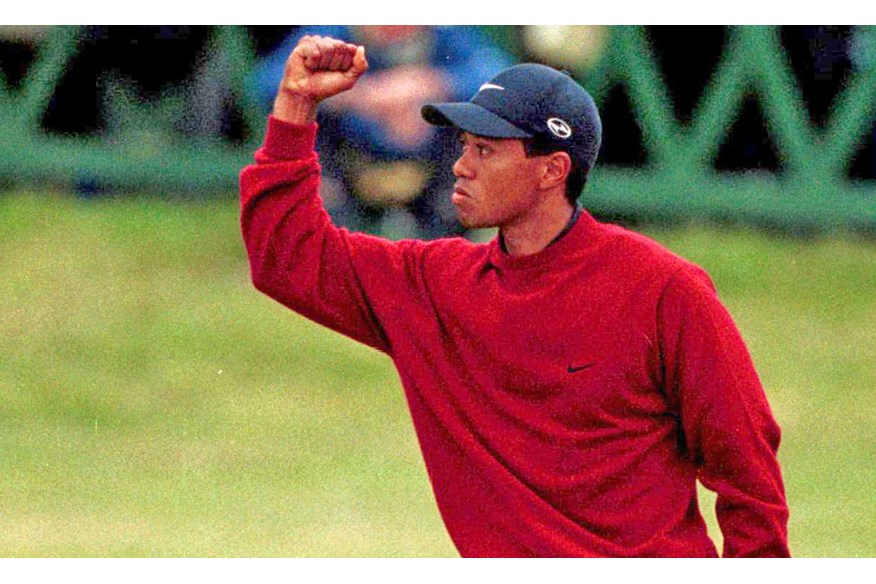
26) The Tiger – 2000, 2005 & 2006
Tiger’s first Open victory at the Millennium Open at St Andrews in 2000 was a steady, in some ways unspectacular affair that merely reinforced what we already knew. Having just won the US Open at Pebble Beach by 15 strokes, the phenom was equally dominant in winning by eight strokes on the Old Course, his 19-under par tally a record for any Major and his 269 a record for any Open at the Home of Golf.
The manner in which Woods navigated his ball around the Old Course was astonishing, never once finding any of the 112 sand traps lying in wait. Here was a man on the way to completing the career Grand Slam at the age of 24 and in complete control of every facet of his game.
It would have been more astonishing had it not, by this point, become par for the course. Comparatively speaking, his second Open victory five years later, again at St Andrews and securing a second Grand Slam, wasn’t extraordinary enough to grace this list. Indeed, if anything, Tiger’s victory was overshadowed by the retiring Jack Nicklaus. Far more significant was his third Open victory, delivered the following year at a sun-scorched Hoylake (30).
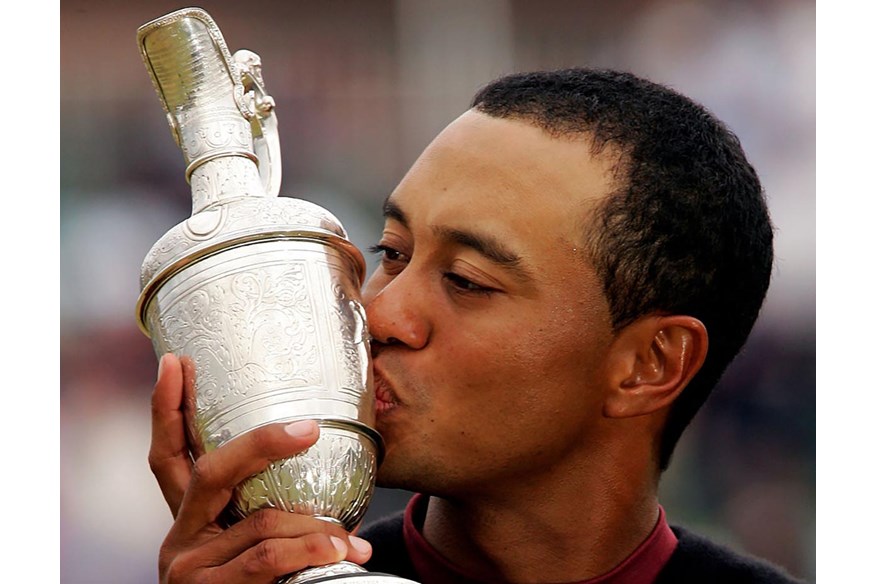
Opting to leave his driver in the bag, Tiger produced a masterclass in mid and long-iron precision to chart safe passage around the perilous pot bunkers. Never racing away from the pack as he had done in 2000, Woods led from Friday morning onwards, finally shaking off the chasing pack with three birdies in a row from the 14th to win by two. If not his greatest Major performance, it was certainly his most emotional.
Breaking down at the end, Tiger dedicated the victory to Earl Woods, his father and mentor having passed away two months previously. “I wish he could have seen this one last time,” reflected Eldrick, the cold, clinical champion reduced to mere mortal.
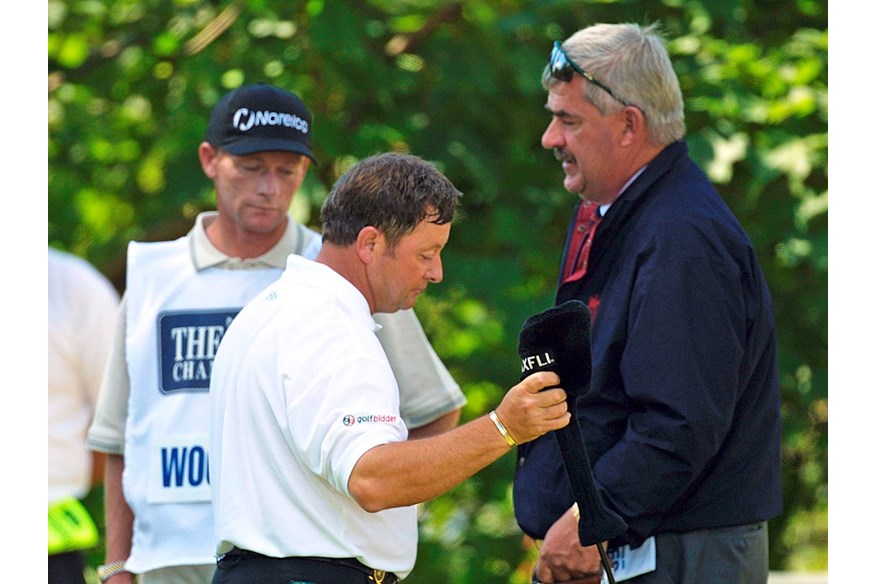
27) Woosie’s woe – Royal Lytham, 2001
David Duval won in 2001 at Royal Lytham, but that isn’t what many of us remember that Open for.
We recall more readily, and still with a wince, the sight of Ian Woosnam flinging his club into the bushes beside the 2nd tee, having been informed by his caddie that they were carrying one weapon too many.
On the final day, with Woosie tied for the lead, the Welshman hit the ground running, birdieing the 1st to ignite a charge. Until… “You’re going to go ballistic,” announced the caddie, “we have 15 clubs.”
Woosie duly went ballistic, declared the two-shot penalty and lost all momentum. Visibly shaken, he finished in a tie for third, rather than with his hands on the Claret Jug.
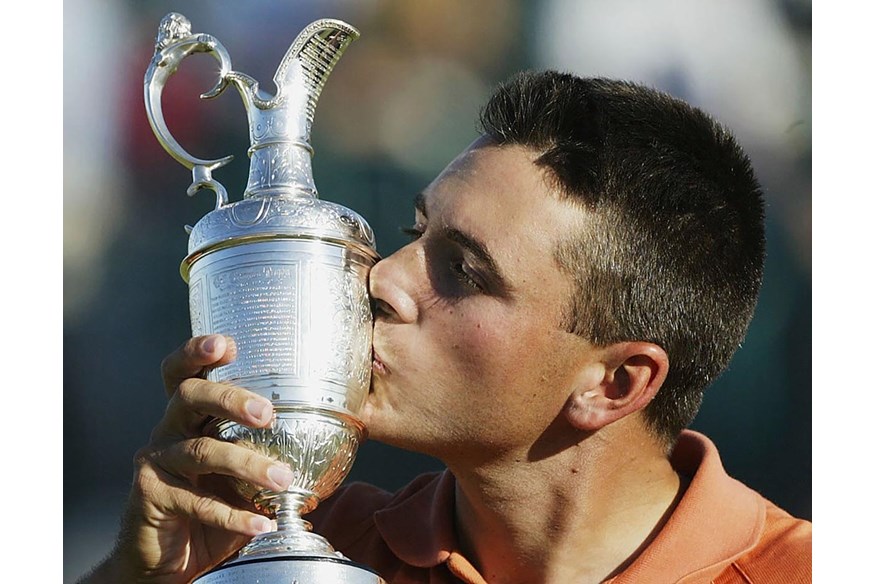
28) Bjorn and Ben – Royal St George’s, 2003
An unknown rookie from Ohio, Ben Curtis had no links or Major experience when he arrived at Royal St George’s in 2003, and he’d never had a top-10 finish in a PGA Tour event. Yet the 26-year-old made a very clever move early on – he hired caddie Andy Sutton from nearby Maidstone.
With Sutton’s nous and Curtis’ sublime putting stroke, the duo were to prove too good for a chasing pack that included Tiger Woods, Vijay Singh and Thomas Bjorn, who appeared to be home and hosed until it took three swipes to escape a bunker on 16.
Bjorn’s bogey, double-bogey, bogey, par finish let slip a three-stroke lead with four to play, and Curtis was the first player since Francis Ouimet in 1913 to win a Major at the first attempt.
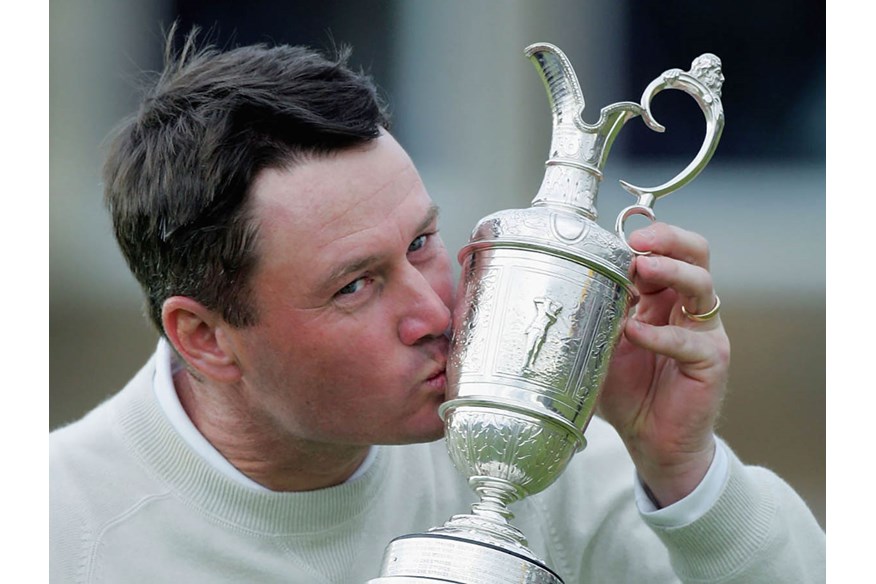
29) Giant Slayer – Royal Troon, 2004
Todd Hamilton seriously considered quitting the game until he won an unconditional card seven months earlier, making his victory at Troon all the more remarkable. Hamilton dispatched all of the era’s so-called ‘Big Five’ en-route to defeating a disbelieving Ernie Els in a four-hole play-off. “I knew I was a decent golfer,” said Hamilton, and he was… but he hasn’t won anything since.
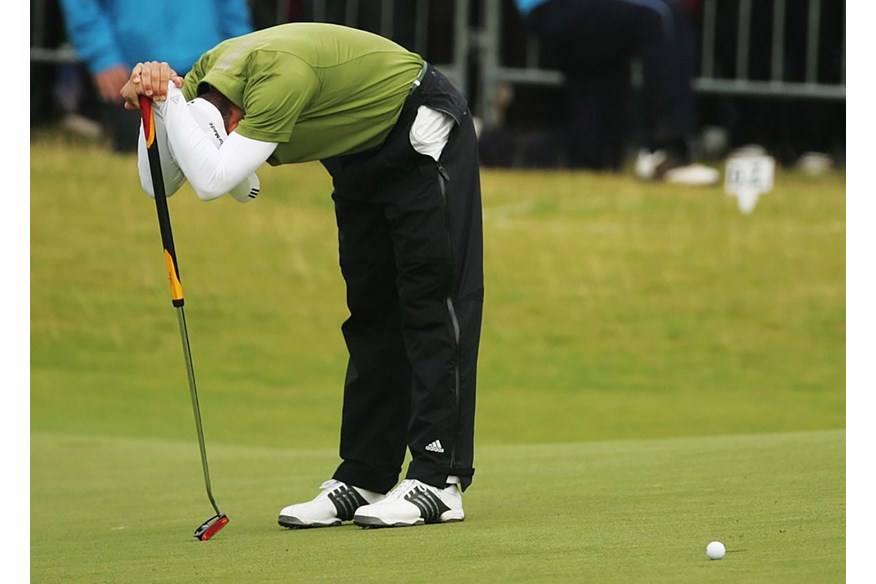
30) Sergio misses – Carnoustie, 2007
A decade before he would finally break his duck, Sergio Garcia was already many people’s pick as the best golfer without a Major. The Spaniard had spent almost seven years inside the world’s top 10 and clocked up 13 professional wins. He’d registered 12 top-10 finishes in Majors, including five in the last six Opens. He just needed to win one.
Opening his 2007 campaign with a birdie en route to an opening round 65, this looked sure to be his year. He was the overnight leader on Thursday, Friday and Saturday – the first time he’d led a Major after 54 holes. Garcia extended his overnight lead with three birdies and a par in the first four holes on Sunday. Everything was in order.
El Nino was finally ready for his date with destiny. But things are never quite that simple at ‘Carnasty’.
Challengers Padraig Harrington and Andres Romero began making birdies up ahead, while Garcia faltered with
three bogeys in the next four holes. When Harrington eagled the 14th, Garcia was bumped from the top of
the leaderboard for the first time since Thursday.
As the Irishman reached the 18th tee with a one-shot lead and bogey-free all day, it looked set to be another heartbreaking near-miss for the gifted Garcia.
But it’s not over until it’s over, especially at Carnoustie, and especially on the hole that undid Jean van de Velde the last time The Open was in town. Harrington, himself seeking to break his Major duck, found Barry Burn twice, but escaped with a double bogey. That left Garcia needing a par to win the tournament. Finding a greenside bunker with his approach, he splashed out to 10 feet. Putting has never been Garcia’s greatest asset, and the putt that would have sealed victory lipped out, forcing a play-off. When Garcia bogeyed the first of four extra holes while Harrington made birdie, the writing was on the wall.
The loss would have been painful enough, but coming against a man with whom he’d never seen eye-to-eye, dating back to an argument at the 2003 Seve Trophy between Harrington and Garcia’s idol, Jose Maria Olazabal, it was almost too much to handle.
“He was a very sore loser,” said Harrington later. “I was as polite and generous as I could be, but he continued to be a very sore loser.”
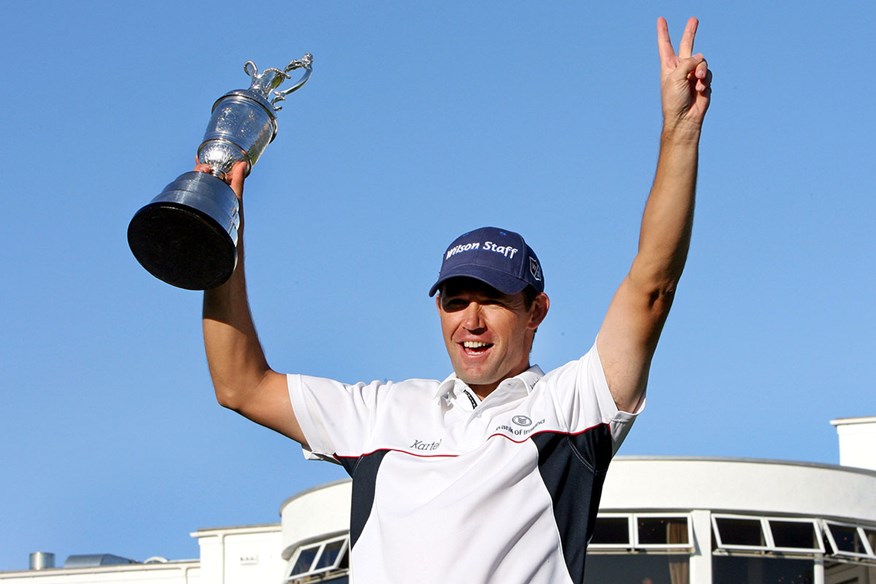
31) Paddy’s unlikely reprise – Royal Birkdale, 2008
Winning the Claret Jug is hard, but retaining it is so much harder. Only five men had achieved the feat since World War II, and no European had managed back-to-back Open wins since James Braid in 1905-’06.
The omens weren’t good then for reigning champion Padraig Harrington, heading into the 2008 Open Championship at Royal Birkdale. A successful defence became even more unlikely when the Irishman injured his wrist practising on the Saturday before the tournament. “On Sunday I couldn’t even lift a club to chip,” he said. “If it wasn’t The Open, I would have pulled out.” Managing only nine holes of practice all week, Harrington admitted on the night before the tournament that he wasn’t sure he’d be able to tee it up the following morning.
But tee it up he did. And, despite 45mph winds that meant nobody could avoid going into The Open’s notoriously thick rough, Harrington’s wrist endured. Two shots off Greg Norman’s lead going into the final round, Paddy battled to the top as those around him faltered, giving him a two-shot lead with two holes to play.
The crowd drew its breath as Harrington reached for a fairway wood to play his second shot on the par-5 17th, a risky move with wind howling off the left, meaning Harrington had to aim into the grandstand. “We’re still in this,” whispered Greg Norman to his caddie.
But Harrington’s bravery paid off with one of the greatest shots in Open history, a flushed 5-wood that settled three feet from the cup, setting up a decisive, history-making eagle.
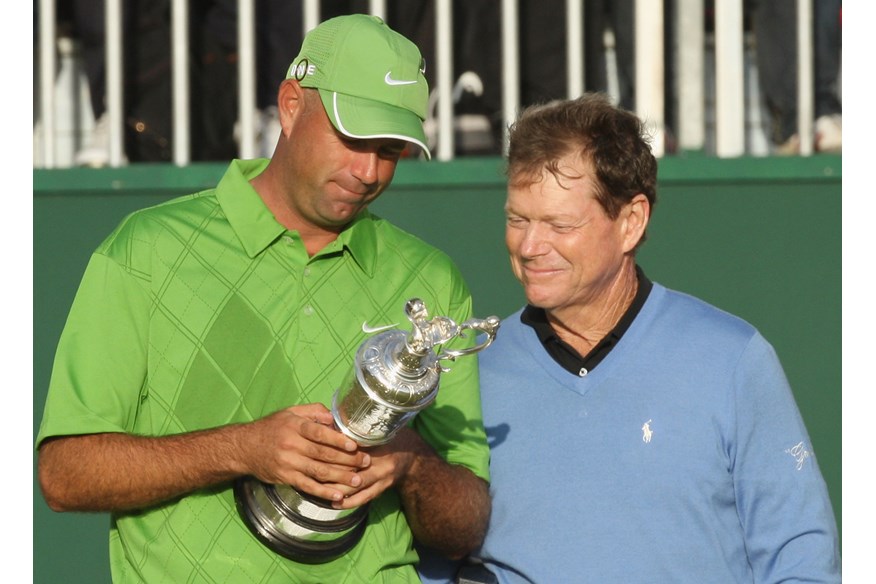
32) A hell of a story – Turnberry, 2009
A birdie on the 71st hole gave Tom Watson the lead by a stroke, just as it had done on the Ailsa’s sun-kissed links 32 summers earlier. This time, Watson’s nearest challenger wasn’t anything close to the calibre of his relentless pursuer in 1977 – for Jack Nicklaus and the ‘Duel in the Sun’, read the Majorless Stewart Cink and the more prosaic ‘Miracle of Turnberry’.
Alas, for every romantic watching, the Watson of 2009 was 59 and only nine months on from undergoing hip surgery – this Old Tom was battling 155 others, the ravages of time and some very unlikely odds.
To the final hole and a likely four strokes from victory, a solid iron down the middle suggested no concerns, the pressure of equalling Harry Vardon as the most decorated Open golfer of all time not weighing unduly on Watson’s shoulders, or his mind. His second shot betrayed the first signs of nerves, however, racing over the back of the green and into the short rough. Standing over his third, a tricky putt for victory that he knew he couldn’t leave short, his stroke galloped eight-feet past the hole, the return for victory never given a chance,
left short and right of the hole.
Watson was mortally wounded, pulled back into a four-hole play-off, his unlikely chance gone. Four holes later, as Cink hoisted the Claret Jug, Watson was left to regret what might have been. “The dream almost came true,” he smiled. “It would have been a hell of a story, wouldn’t it?” Would have been?
It already was.
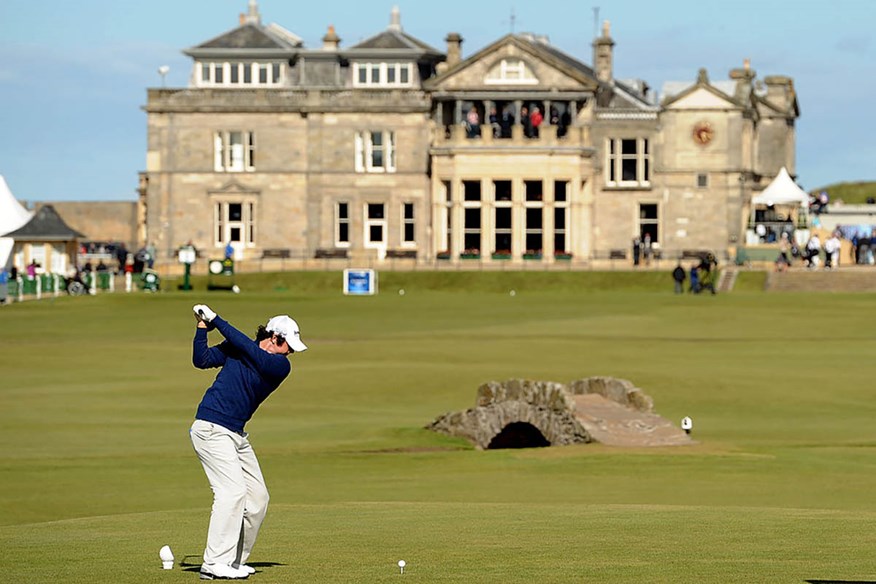
33) McIlroy arrives with a bang – St Andrew’s, 2010
If anyone doubted the talents of then 21-year-old Rory McIlroy they were laid bare in the first round at St Andrews as he shredded The Old Course on his way to a nine-under 63. That included a few other missed opportunities and the youngster from Northern Ireland looked unstoppable.
However, fate would decree otherwise as those playing in the afternoon on day two would face terrible weather conditions. McIlroy shot a second-round 80 while South Africa Louis Oosthuizen, fresh from an opening 65, would be in the second group out and got round in 67 before the weather turned.
At halfway the South African led by five and was never challenged while McIlroy bounced back well to finish in a tie for third. His time at The Open would come four years later (No 37).
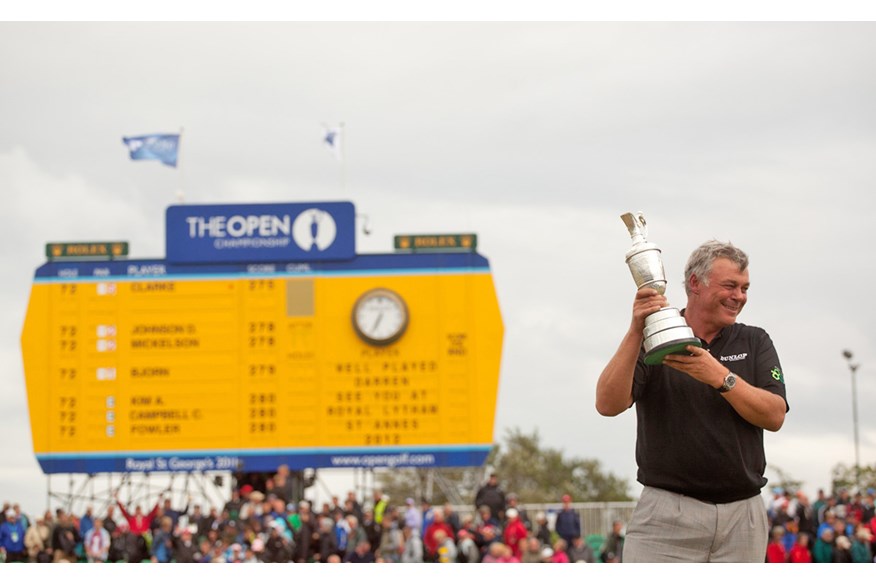
34) The long shot – Royal St George’s, 2011
As a man who grew up playing links golf, Darren Clarke had the game to win an Open long before it finally, unexpectedly happened at Royal St George’s in 2011. A 125-1, overweight, 42-year-old outsider, no player had taken more than 16 appearances to win the Open before, and Clarke was on Open number 20.
Perhaps buoyed by the Major successes of compatriots Rory McIlroy and Graeme McDowell, Clarke overturned odds and expectation to hold off first Phil Mickelson and later Dustin Johnson to finally lay his hands on the Claret Jug, the first home winner since Paul Lawrie in 1999 and the oldest Champion Golfer since 44-year-old Roberto de Vicenzo in 1967.
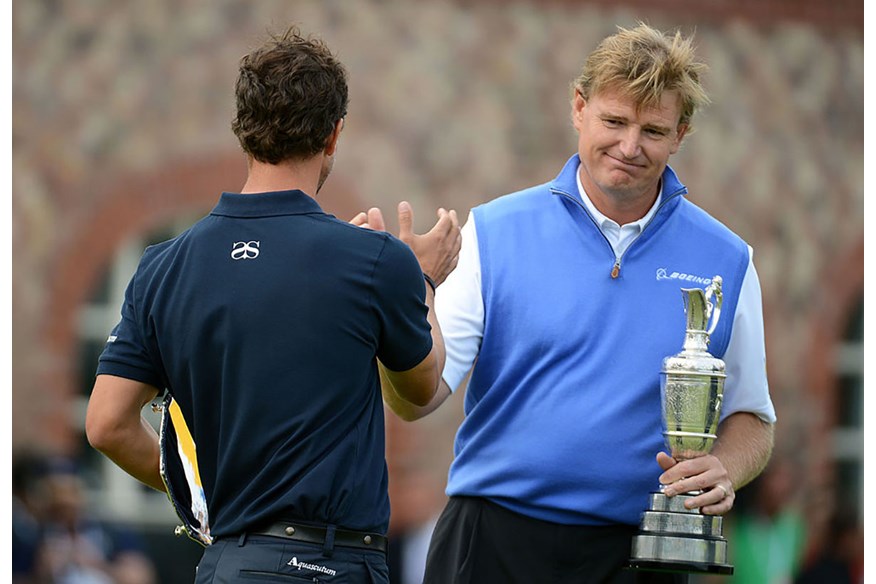
35) Great Scott – Royal Lytham, 2012
The name on the trophy in 2012 read Ernie Els, and while the South African fully deserved a victory, he never led this Open Championship until the moment he won it. The Claret Jug’s engraver could have been forgiven for starting work early engraving Adam Scott’s name into the trophy.
Four ahead with four to play, Scott manufactured a meltdown for the ages, bogeying each and handing the trophy over to his good friend Els. Securing his second Claret Jug 10 long years after his first, Els’ unlikely success had been built on the back of a supreme four-under back nine for a closing 68. Sadly, for both men, it’s not that fact anyone remembers.
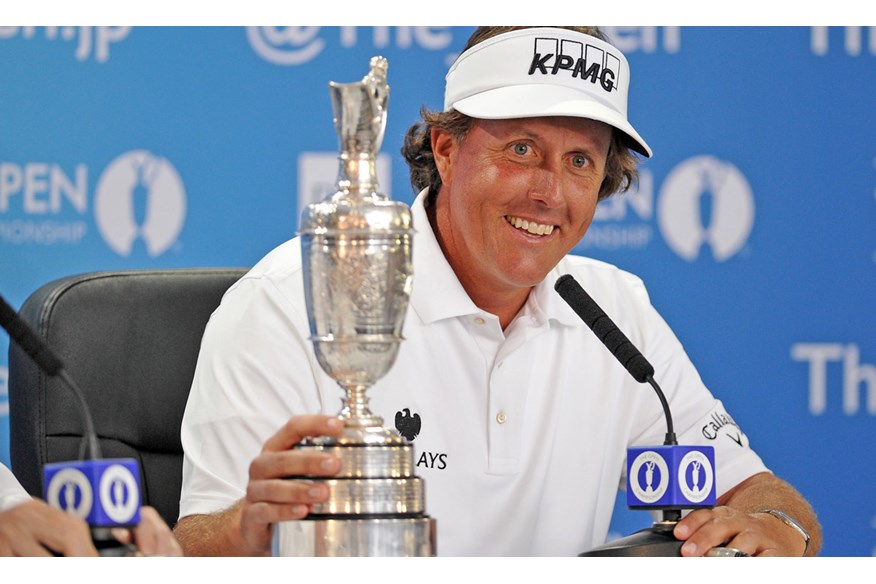
36) Phil’s fire – Muirfield, 2013
Despite entering the final day’s play at Muirfield in 2013 five shots behind leader Lee Westwood, and despite an often uncomfortable relationship with links golf, and despite suffering another heartbreak at the US Open just a month prior, Phil Mickelson never doubted that he would rise from the pack at Muirfield. As all around him staggered and stumbled on the final day, Mickelson blazed to the top of the leaderboard on the back of one of the finest final rounds in Open Championship history.
The fireworks came late, with birdies on 13, 14, 17 and 18 seeing him home in 32 for a 66, the lowest round of the week. Like Darren Clarke two years earlier, Lefty had a Claret Jug in his 20th appearance. “This is a day and a moment I will cherish forever,” he beamed afterwards. “I played arguably the best round of my career.”
37) Destiny calling – Royal Liverpool, 2014
Those who saw Rory McIlroy dismantle St Andrews in the first round of 2010 Open (No 33) must have been wondering when Hollywood’s prodigal son would come back and finish the job. The Northern Ireland star would only have to wait four years to fulfil what many considered his destiny.
Again, like on The Old Course, he led after the first round but this time, at Hoylake, he was never headed, becoming just the sixth Open champion to go wire-to-wire and becoming just the third player in history to win a third different Major by the age of 25 (Jack Nicklaus and Tiger Woods were the others).
Rory was six clear going into the final round although both Rickie Fowler and Sergio Garcia had a good run at closing the gap, the Spaniard’s bid for glory coming unstuck after he found sand at the 15th. That dropped him three behind the leader and the soon-to-be-champion birdied 16 to ease him to 17 under and that proved a figure which was out off reach for the rest.
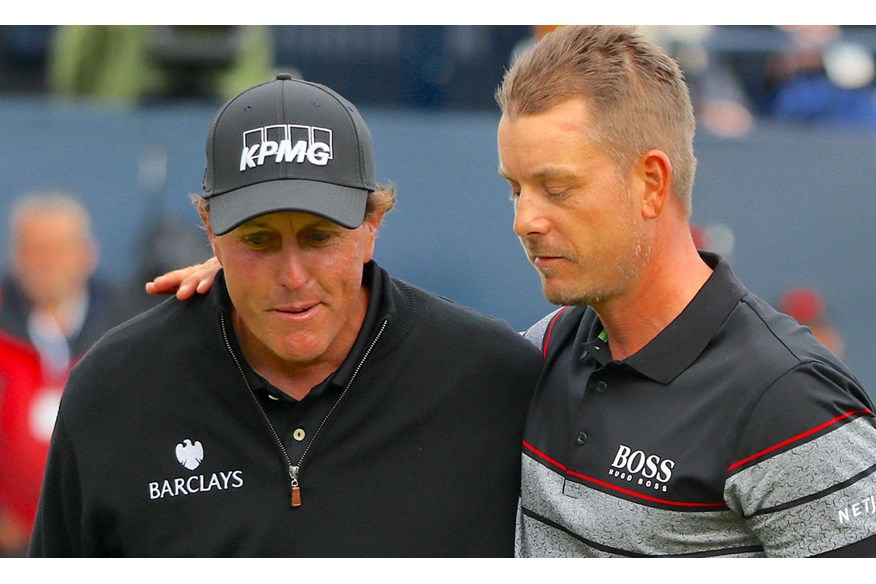
38) Last man standing – Royal Troon, 2016
Events like the 145th Open Championship at Royal Troon are rare and wonderful things. Iconic, they immediately and forever define the careers of those involved. Legendary, they sit for a lifetime in the minds, hearts and souls of those golfers who watched. Transcendent, they display the greatest game to a wider world captivated by its ability to convey sport at its most inspirational best. Bobby Jones’ Grand Slam in 1930 is an obvious example. Ben Hogan’s 1953 Open victory at Carnoustie qualifies.
The ‘Duel in the Sun’ at Turnberry between Jack Nicklaus and Tom Watson is another, as is Nicklaus claiming the 1986 Masters at the age of 46. This duel, this epic battle sits alongside all of the above.
With the third-placed finisher, J.B. Holmes, a mere speck in their joint rearview mirror, Henrik Stenson and Phil Mickelson produced golf of sublime quality.
At the end of his blitzkrieg of brilliance, the new champion finished an astonishing and unprecedented 20-under par, three shots ahead of the gallant runner-up and a yawning 14 strokes clear of the bronze medallist. This was McEnroe versus Borg, Ali versus Frazier, Messi against Ronaldo – cubed.
The final round played by Stenson, an eight-under par 63 that equalled the best-ever 18-hole score in any Major championship, contained 10 birdies and, almost unbelievably, a brace of three-putts. Almost beyond argument from all but those who still champion Johnny Miller’s closing 63 at Oakmont to win the 1973 US Open, it must be the greatest fourth-day ever produced in any of the four events that represent the highest level of the game. As a measure of the Swede’s play, Mickelson’s four-round aggregate of 267 would have won 140 of the previous 144 Opens.
There are other comparisons to be made, the best with the aforementioned Nicklaus-Watson battle. Almost four decades and just over 20 miles removed from ‘Stenson-Mickelson’, it sits timelessly in the memories of all golfers. Or at least it did. For this latest version was better in almost every way. The quality of the golf by both protagonists was superior (for Nicklaus struggled tee-to-green that week), and so too the way these modern-day Goliaths elevated the performance of the other.
Besides, both Jack and Tom think so too. “I thought Tom and I played great and had a wonderful match,” the 76-year-old Nicklaus said. “But theirs was even better.”
Watson was equally effusive. “People, when they talk about The Open, they will say, ‘Yeah, Stenson-Mickelson at Troon.’ They will always talk about that in the highest echelon of conversation about The Open Championship. Jack and I, we had a pretty good contest. But, they were 20-under and 17-under; Jack and I were 12-under and 11-under. If you had to rank it, you’d rank that above ours, for sure.”
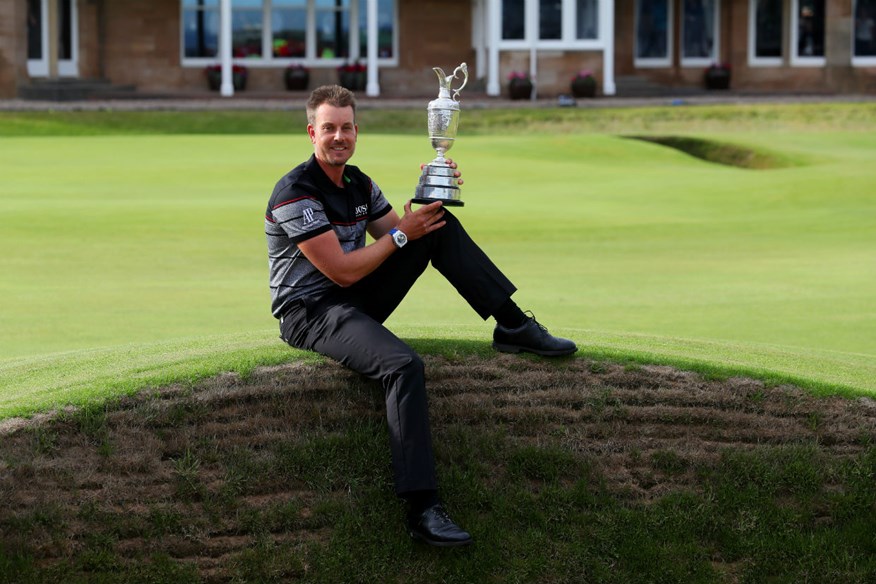
Neither man walked off the 18th green with any real idea of what they had just been part of. While it must have been clear to both that they had just created something more than special, neither had a clue when it came to the details. For one thing, Stenson had no idea what he had just shot; the 29th 63 in Major championship history. And Mickelson was just as bad. When he sat down in the scorer’s hut to check his card, his eyes were drawn to the adjacent scoreboard, displaying the pair’s hole-by-hole scores.
Along the line he went, from the 1st to the 18th, before turning to Stenson and saying, “You made 10 f***ing birdies!” Such ignorance speaks to the purity of the contest. Knowing the rest were nowhere, Stenson and Mickelson focused only on each other.
In doing so, they represented the very best that golf has to offer.
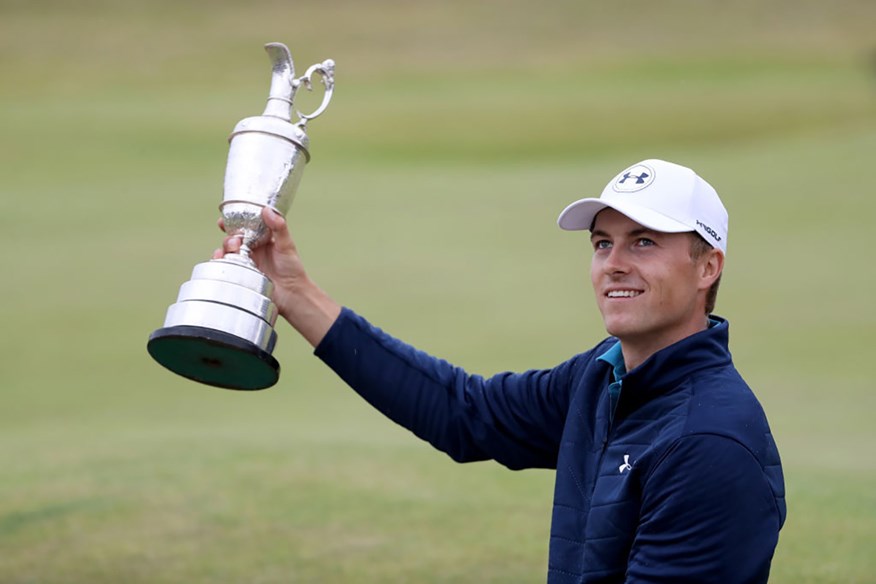
39) Spieth’s lucky 13 – Royal Birkdale, 2017
There’s an old adage that says it’s better to be lucky than good – and that certainly held true for Jordan Spieth on the 13th hole in the final round of the 2017 Open. Leading after each of the first three rounds, the American found himself behind for the first time after an extraordinary 13th hole left him trailing compatriot Matt Kuchar
by a stroke.
Spieth’s hopes appeared to unravel when his blocked drive flew almost 100 yards off line and struck a spectator standing atop a towering dune before tumbling into a quagmire of fescue and prehistoric ferns. But it was at that point that Lady Luck arrived on the scene.
First, Spieth was lucky to find his golf ball, then he was lucky the R&A hadn’t thought to declare the range out-of-bounds. He was then lucky to be granted relief from the tour trucks, then lucky to be able to play his third shot from pristine turf. Finally, he was lucky that his slightly chunked, blind long-iron approach over the dunes avoided a cluster of penal pot bunkers on the right edge of the fairway and instead nestled some 30 yards away from the pin.
Understandably energised by such outrageous fortune, Spieth pulled off an amazing up-and-down. And sensing that his name was on the Claret Jug, he went on a birdie, eagle (“go get that!”), birdie, birdie run over the next four holes to establish a three-stroke lead over a shell-shocked Kuchar. With that victory, Spieth had part three of a possible career Grand Slam – and golf one of its greatest tales.
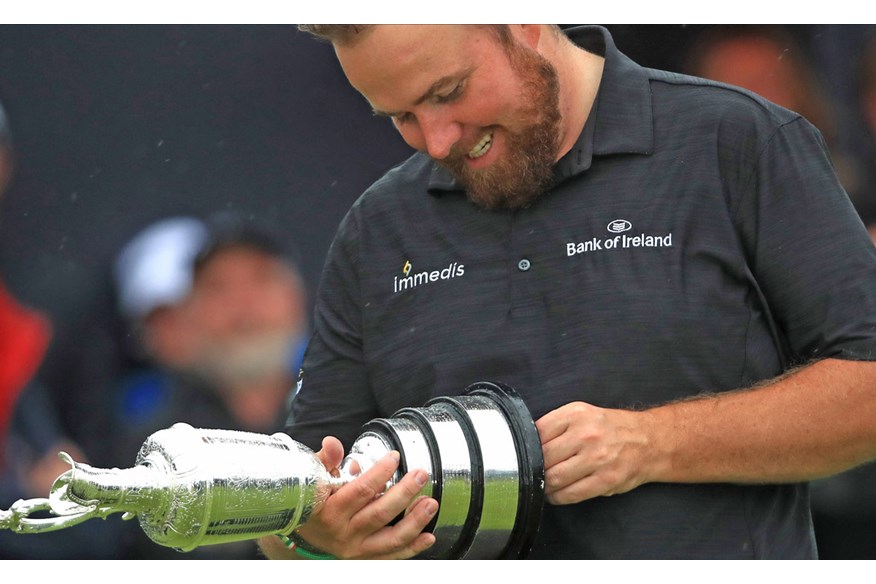
40) A Homecoming – Royal Portrush, 2019
Shane Lowry made the 68 years between Open Championships in Northern Ireland worth the wait, winning by six shots in front of a sell-out home crowd at Royal Portrush in 2019.
“I can’t believe this is me standing here,” he said as he cradled the Claret Jug. “I can’t believe this is mine.”
Royal Portrush last hosted The Open in 1951, the only time it had been outside Scotland or England.
Record crowds pinned their hopes at the start of the week on local hero Rory McIlroy, who missed the cut by a shot. They celebrated Darren Clarke hitting Thursday’s first tee shot and Portrush native Graeme McDowell had the loudest cheers as he walked up the 18th green on Sunday.
But then came Lowry, who joined Padraig Harrington as Irishmen to win Majors, while McIlroy, McDowell, Clarke and Fred Daly are Major champions from Northern Ireland. “Everyone knows we’re all one country when it comes to golf,” Lowry said.
Sky’s Ewen Murray summed up the week, saying Royal Portrush had “taken The Open to a new level”.
What made it so special? “Probably 68 years of not being here,” said Murray. “In a small country where there are more sheep than people, Northern Ireland can bask in the glory of an outstanding achievement and they delivered one of the best Opens in modern times.
The fact an Isle of Ireland native prevailed added to a legendary week. The coastline of this enchanting corner of Northern Ireland will forever be remembered for a fairytale ending to the greatest championship in golf.”
MORE FROM THE OPEN
Jack Nicklaus Exclusive Interview
Zach Johnson “I took the Claret Jug to a waffle house!”
-
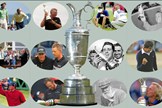 The greatest moments in the history of the Open Championship
The greatest moments in the history of the Open Championship
-
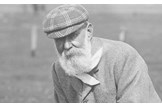
-
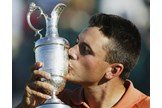 Ben Curtis won The Open in 2003.
Ben Curtis won The Open in 2003.
-
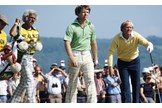
-
 Tom Watson and Jack Nicklaus enjoyed a legendary battle at Turnberry in 1977
Tom Watson and Jack Nicklaus enjoyed a legendary battle at Turnberry in 1977
-
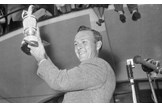 Arnie Palmer celebrates winning The Open at Royal Birkdale in 1961
Arnie Palmer celebrates winning The Open at Royal Birkdale in 1961
-

-

-
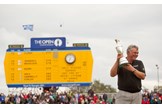 Darren Clarke celebrates winning the 2011 Open at Royal St George's
Darren Clarke celebrates winning the 2011 Open at Royal St George's
-
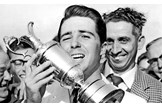 Gary Player celebrates winning the 1959 Open
Gary Player celebrates winning the 1959 Open
-
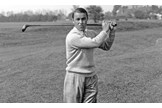 Gene Sarazen's revolutionary sand wedge helped him win the 1932 Open
Gene Sarazen's revolutionary sand wedge helped him win the 1932 Open
-
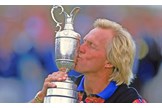 Greg Norman kisses the Claret Jug after winning the 1993 Open
Greg Norman kisses the Claret Jug after winning the 1993 Open
-
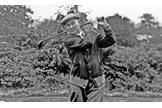 Harry Vardon won six Open Championships
Harry Vardon won six Open Championships
-
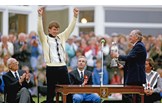 Nick Faldo celebrates winning the 1987 Open at Muirfield
Nick Faldo celebrates winning the 1987 Open at Muirfield
-
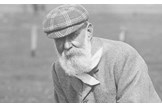 Old Tom Morris won multiple Opens in the 19th century
Old Tom Morris won multiple Opens in the 19th century
-
 Phil Mickelson and Henrik Stenson after their battle at Troon in 2016
Phil Mickelson and Henrik Stenson after their battle at Troon in 2016
-
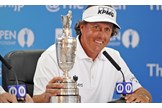 Phil Mickelson celebrates winning the 2013 Open at Muirfield
Phil Mickelson celebrates winning the 2013 Open at Muirfield
-
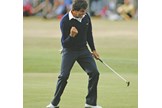 Seve Ballesteros celebrates winning the 1984 Open at St Andrews
Seve Ballesteros celebrates winning the 1984 Open at St Andrews
-
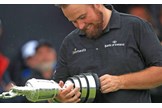 Shane Lowry won the 2020 Open at Royal Portrush
Shane Lowry won the 2020 Open at Royal Portrush
-
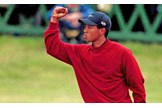 Tiger Woods celebrates winning the 2000 Open at St Andrews.
Tiger Woods celebrates winning the 2000 Open at St Andrews.
-
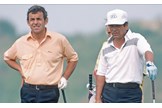 Tony Jacklin and Lee Trevino had a great battle in the 1972 Open
Tony Jacklin and Lee Trevino had a great battle in the 1972 Open
-
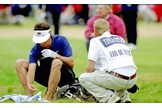 Jean Van de Velde in the 1999 Open at Carnoustie
Jean Van de Velde in the 1999 Open at Carnoustie
-
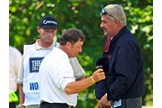 Ian Woosnam discovers he has too many clubs in the bag at The 2001 Open.
Ian Woosnam discovers he has too many clubs in the bag at The 2001 Open.
-
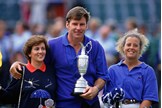 Nick Faldo won The Open at Muirfield in 1992.
Nick Faldo won The Open at Muirfield in 1992.
-
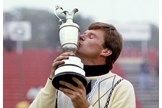 Nick Faldo won The Open at Muirfield in 1987.
Nick Faldo won The Open at Muirfield in 1987.
-
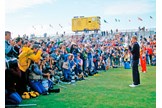 Sandy Lyle won The Open at Royal St George's in 1985.
Sandy Lyle won The Open at Royal St George's in 1985.
-
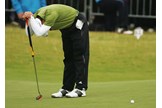 Sergio Garcia reacts to his missed putt at Carnoustie in 2007.
Sergio Garcia reacts to his missed putt at Carnoustie in 2007.
-
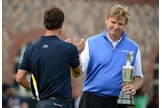 Adam Scott congratulates Ernie Els at the 2012 Open.
Adam Scott congratulates Ernie Els at the 2012 Open.
-
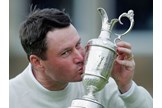 Todd Hamilton won The Open at Royal Troon in 2004.
Todd Hamilton won The Open at Royal Troon in 2004.
-
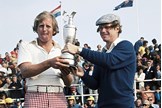 Jack Newton ahead of their 18-hole playoff at the 1975 Open at Carnoustie.
Jack Newton ahead of their 18-hole playoff at the 1975 Open at Carnoustie.
-
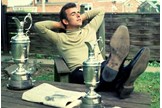 Tony Jacklin relaxes after winning The Open in 1969.
Tony Jacklin relaxes after winning The Open in 1969.
